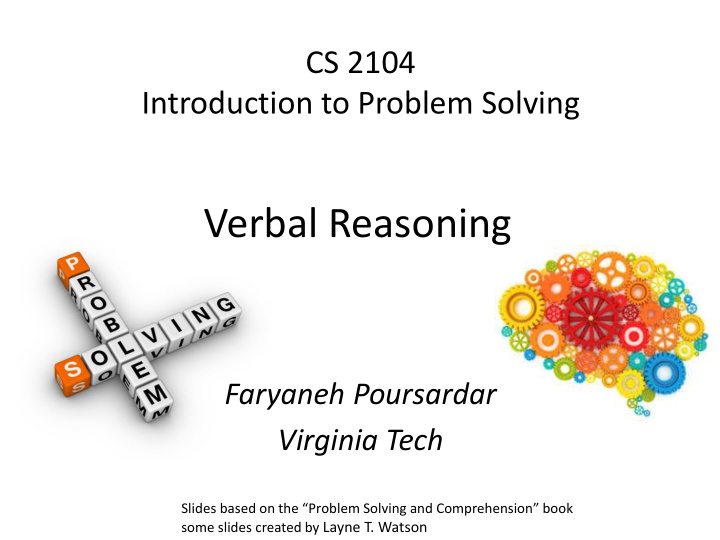



CS 2104 Introduction to Problem Solving Verbal Reasoning Faryaneh Poursardar Virginia Tech Slides based on the “Problem Solving and Comprehension” book some slides created by Layne T. Watson
Verbal Reasoning Problems • For this type of problem, we need to parse the text into the proper steps • Then we need to sort out the steps • Since they can get long and complicated, we usually need to resort to a diagram (externalize the information)
VR Problem 1 Jose is heavier than Fred but lighter than Marty. Write their names in order of weight.
VR Problem 1 Solution • T o expose the reasoning process, we need to spell out the steps involved. • Step 1: Jose is heavier than Fred… [He would be placed above Fred on the diagram.] • Step 2: … but lighter than Marty. [So Marty is placed above Jose in the diagram.]
VR Problem 2 Jack is slower than Phil but faster than Val. Val is slower than Jack but faster than Pete. Write the names in order of speed.
VR Problem 2 Solution
VR Problem 3 If Dumani and Fred are both richer than Tom, and Hal is poorer than Dumani but richer than Fred, which man is the poorest and which one is the next poorest? Write the names of all 4 men in order.
VR Problem 3 Solution
VR Problem 4 • Paul and Tom are the same age. Paul is older than Cynthia. Cynthia is younger than Hal. • Is Paul older or younger than Hal – or can this not be determined from the information?
Other Diagrams • Some problems are best supported by a 2D table. • Some problems need another approach to organizing the information, such as a graph.
VR Problem 5 Three fathers – Pete, John, and Nick – have between them a total of 15 children of which 9 are boys. John has 1 more child than Pete, who has 4 children. Nick has 4 more boys than girls and the same number of girls as Pete has boys. How many boys each do Nick and Pete have?
VR Problem 5 Solution
VR Problem 6 On a certain day I ate lunch at Tommy’s, took out 2 books from the library (The Sea Wolf and Martin Eden, both by Jack London), visited the museum and had a cavity filled. Tommy’s is closed on Wednesday, the library is closed on weekends, the museum is only open Monday, Wednesday, and Friday, and my dentist has office hours Tuesday, Friday, and Saturday. On which day of the week did I do all these things?
VR Problem 7 • Boris, Irwin and Steven are engaged in the occupations of librarian, teacher, and electrician, although not necessarily in that order. The librarian is Steven’s cousin. Irwin lives next door to the electrician. Boris, who knows more facts • than the teacher, must drive 45 minutes to visit Irwin’s house. • What is each man’s occupation?
VR Problem 8 Sally loaned $7 to Betty. But Sally borrowed $15 from Estella and $32 from Joan. Moreover, Joan owes $3 to Estella and $7 to Betty. One day the women got together at Betty’s house to straighten out their accounts. Which woman left with $18 more than she came with?
Step 1. The problem began “Sally loaned $7.00 to Betty.” This is shown below with VR Problem 8 the arrow indicating the direction to which the money must be returned. Solution Step 2. The entire pattern of debts is shown in the following diagram. Step 3. Which girl left with $18.00 more than she came with? The diagram shows that Estella received $3.00 from Joan and $15.00 from Sally, for a total of $18.00. Estella left with $18.00 more than she came with.
VR Problem 9 Lester has 12 times as many marbles as Kathy. John has half as many as Judy. Judy has half as many as Lester. Kathy has 6 marbles. How many marbles each do Lester and John have? You do not need to use algebra to solve this problem.
Six Myths about Reading What speed-reading advocates say: Don’t subvocalize when you read 1. 2. Read only the key words Don’t be a word -by-word reader 3. 4. Read in thought groups You can read at speeds of 1000 or more words a minute – without 5. any loss of comprehension Don’t regress or re-read 6. These things do not work. There are no short cuts to comprehension! Difficult material typically requires re-reading to understand.
Multitasking See notes in the file Multitasking.pptx. 67
Recommend
More recommend